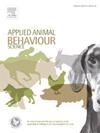Influence of turbidity on group level responses to feeding in the Pacific white shrimp (Litopenaeus vannamei)
IF 2.2
2区 农林科学
Q1 AGRICULTURE, DAIRY & ANIMAL SCIENCE
引用次数: 0
Abstract
The use of behaviour as a tool to improve welfare conditions within aquaculture is increasing, and our understanding of individual and group behaviour of commercially important penaeid shrimp has grown in recent years. However, the majority of studies investigating shrimp behaviour have used clear water conditions allowing for easier observation. Little is known about the influence of water turbidity on the feeding behaviour and social interactions of penaeid shrimp even though they are commonly reared for aquaculture in highly turbid ponds. Here, the behaviour of groups of four Litopenaeus vannamei juveniles (n = 144; 6.42 ± 0.28 g, mean ± S.E., body mass) was observed at three different turbidities; clear water (approximately 2 NTU, Nephelometric Turbidity Unit), medium turbidity (approximately 14.5 NTU) or high turbidity (approximately 30 NTU). Groups of shrimp were observed for 20 min within an experimental arena provided with feed, and video footage analyzed using an automated tracking software (EthoVision XT V14). Feed intake was greater in the high turbidity treatment compared to clear water, although no differences in behaviours related to the feeding area (e.g. time spent feeding, latency to feed) were found between treatments. Turbidity influenced exploratory behaviours, where shrimp held at the medium turbidity were more active than in the other treatments. Shrimp held in high turbidity also moved much more closely to each other than in the other treatments. These results highlight the importance of accounting for turbid water conditions when studying shrimp behaviour.
求助全文
约1分钟内获得全文
求助全文
来源期刊

Applied Animal Behaviour Science
农林科学-行为科学
CiteScore
4.40
自引率
21.70%
发文量
191
审稿时长
18.1 weeks
期刊介绍:
This journal publishes relevant information on the behaviour of domesticated and utilized animals.
Topics covered include:
-Behaviour of farm, zoo and laboratory animals in relation to animal management and welfare
-Behaviour of companion animals in relation to behavioural problems, for example, in relation to the training of dogs for different purposes, in relation to behavioural problems
-Studies of the behaviour of wild animals when these studies are relevant from an applied perspective, for example in relation to wildlife management, pest management or nature conservation
-Methodological studies within relevant fields
The principal subjects are farm, companion and laboratory animals, including, of course, poultry. The journal also deals with the following animal subjects:
-Those involved in any farming system, e.g. deer, rabbits and fur-bearing animals
-Those in ANY form of confinement, e.g. zoos, safari parks and other forms of display
-Feral animals, and any animal species which impinge on farming operations, e.g. as causes of loss or damage
-Species used for hunting, recreation etc. may also be considered as acceptable subjects in some instances
-Laboratory animals, if the material relates to their behavioural requirements
 求助内容:
求助内容: 应助结果提醒方式:
应助结果提醒方式:


